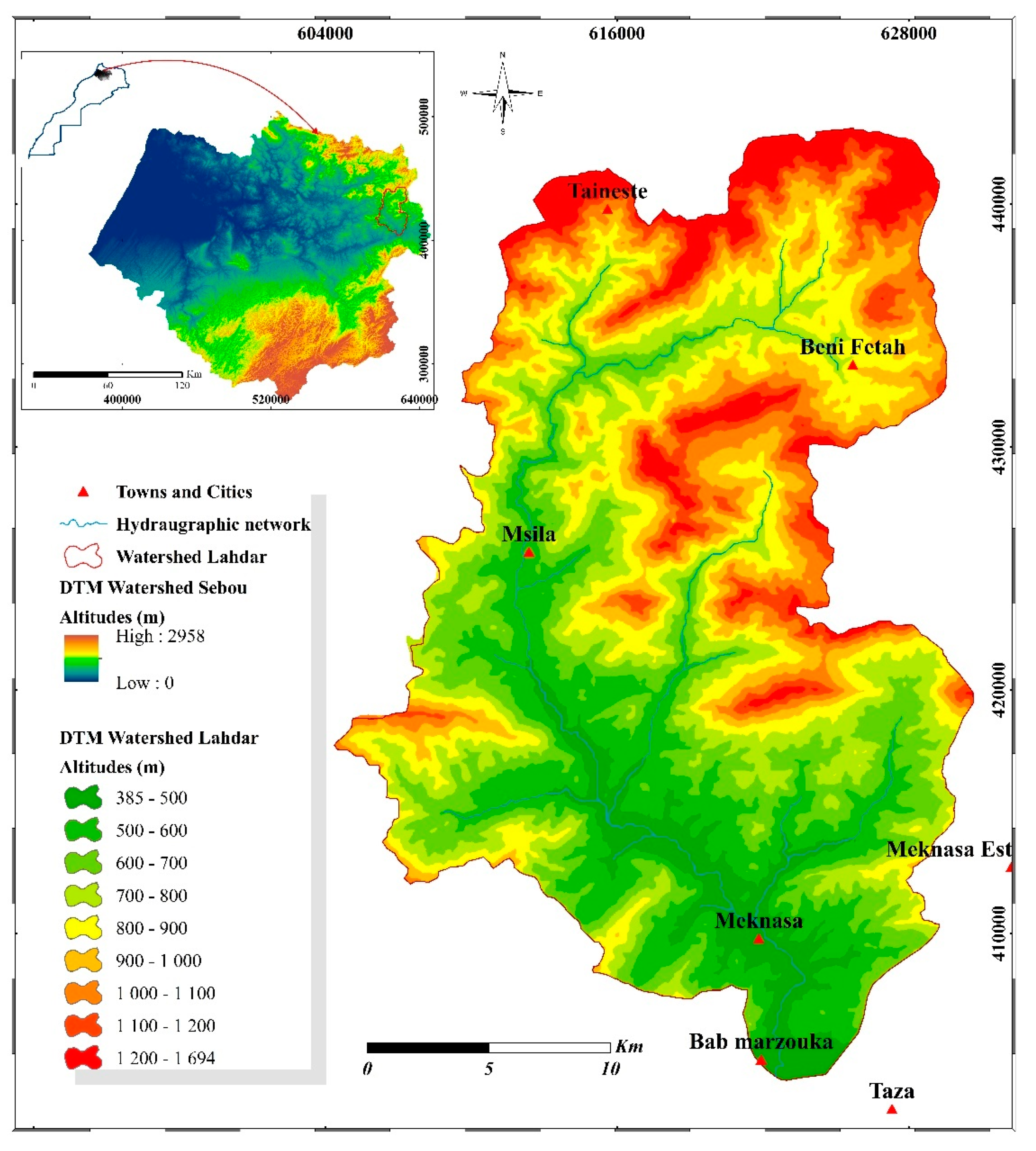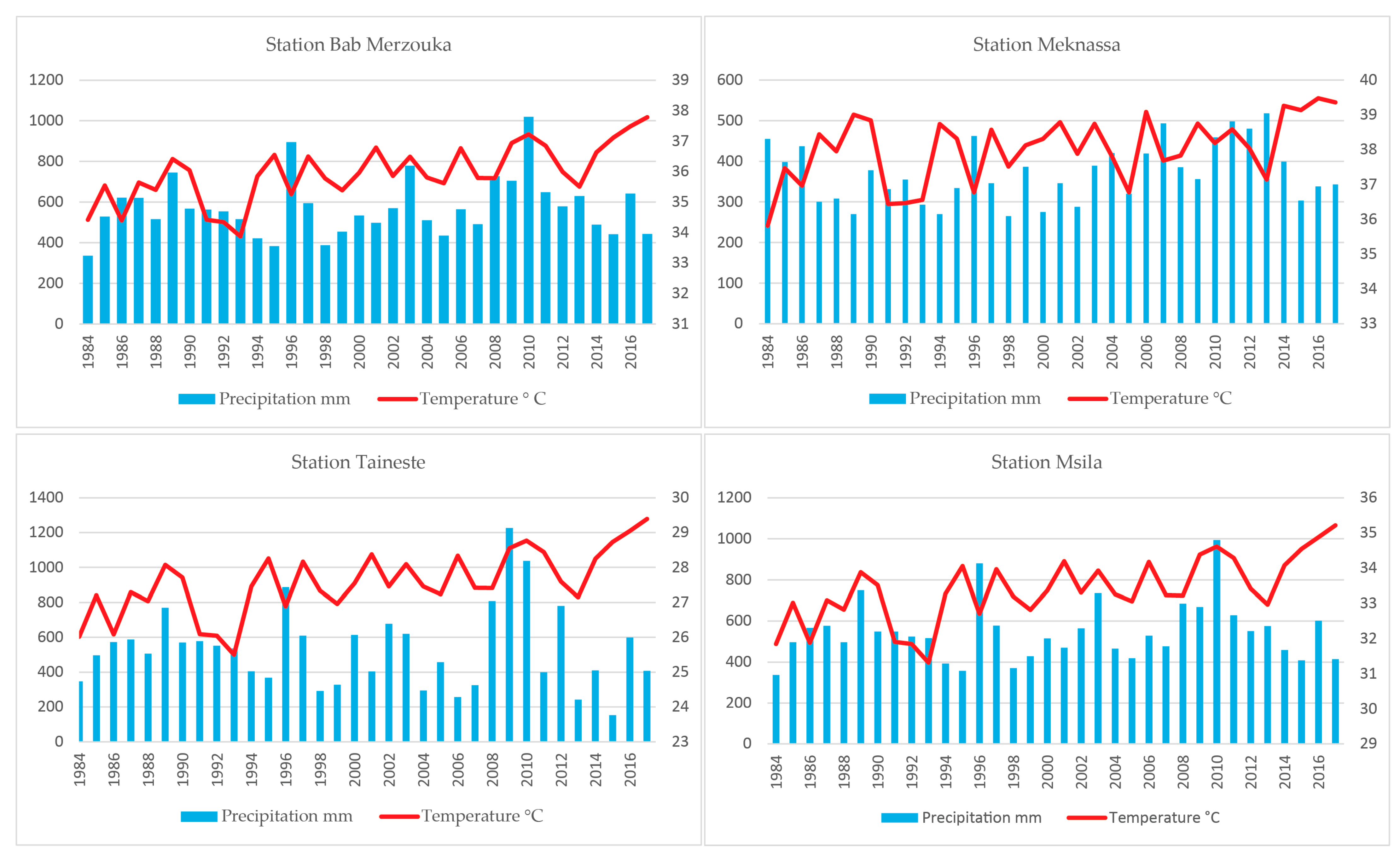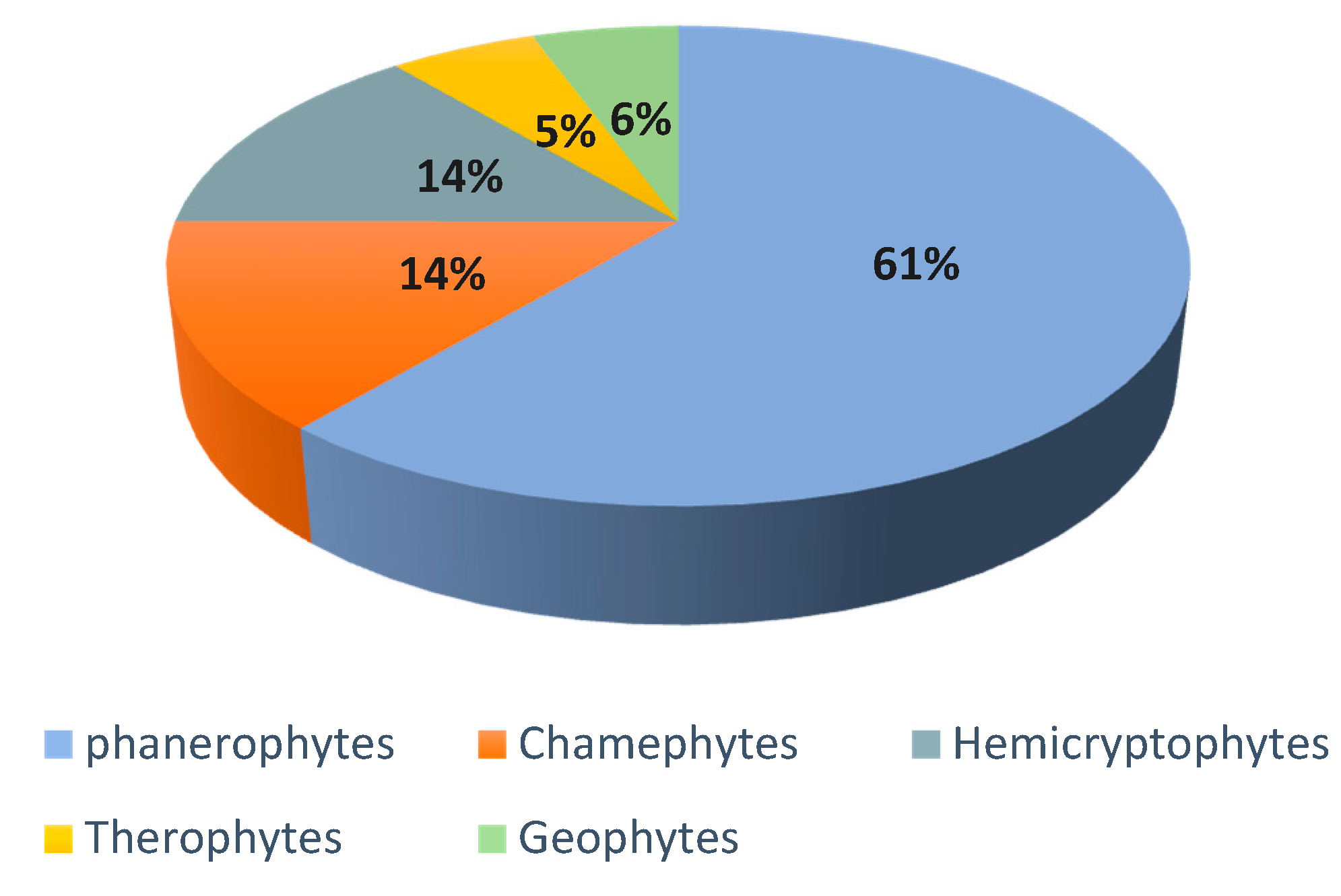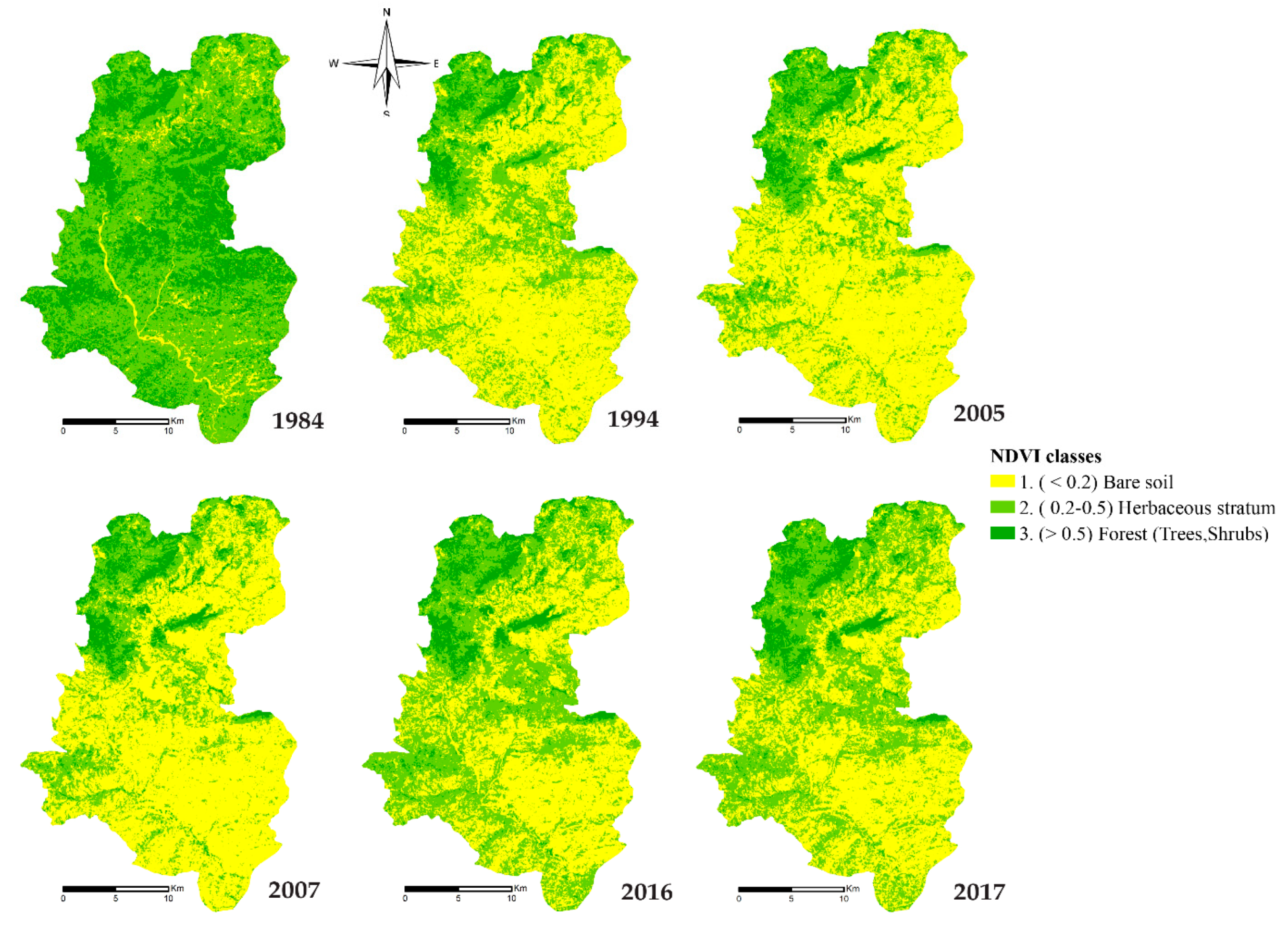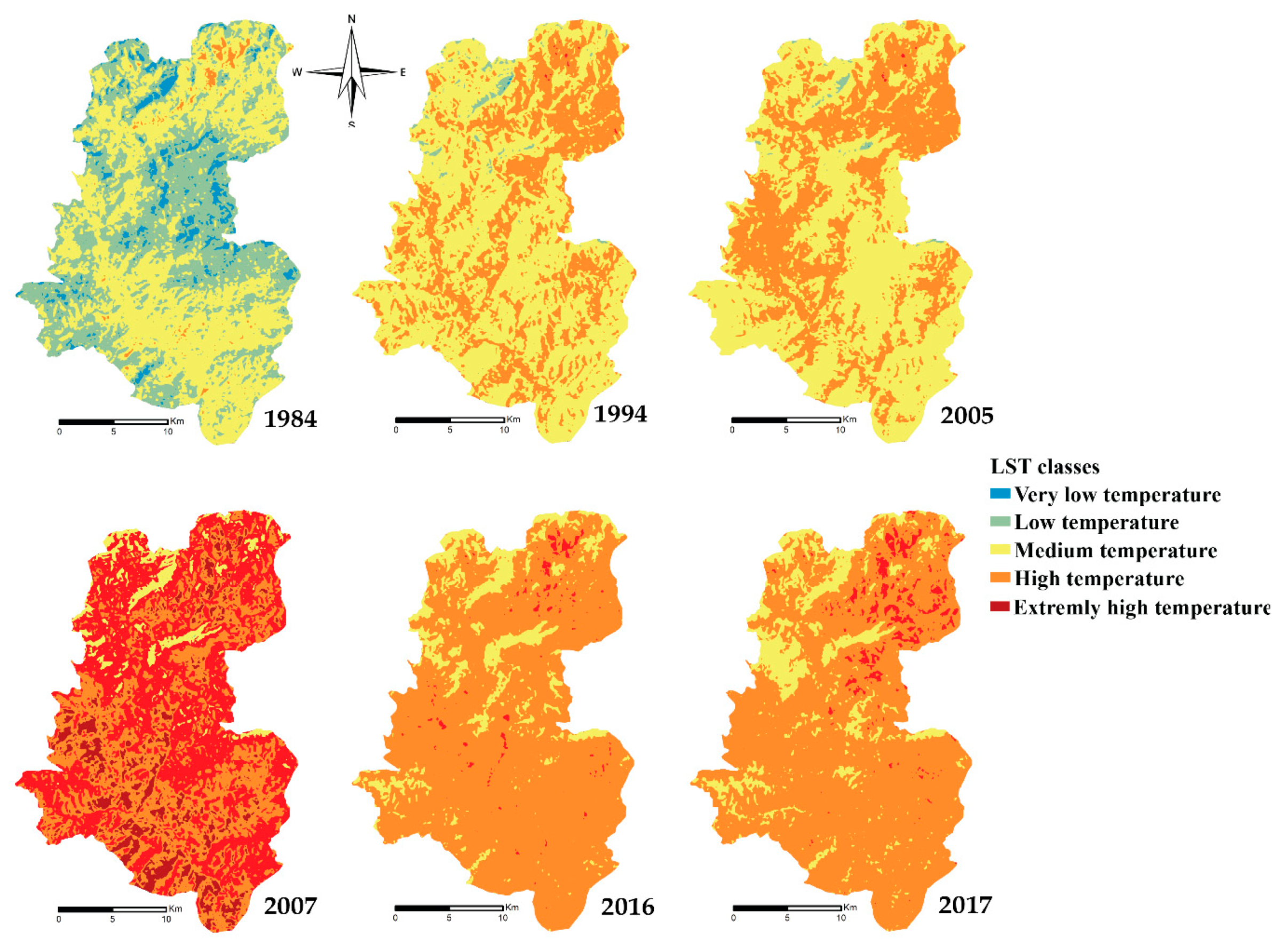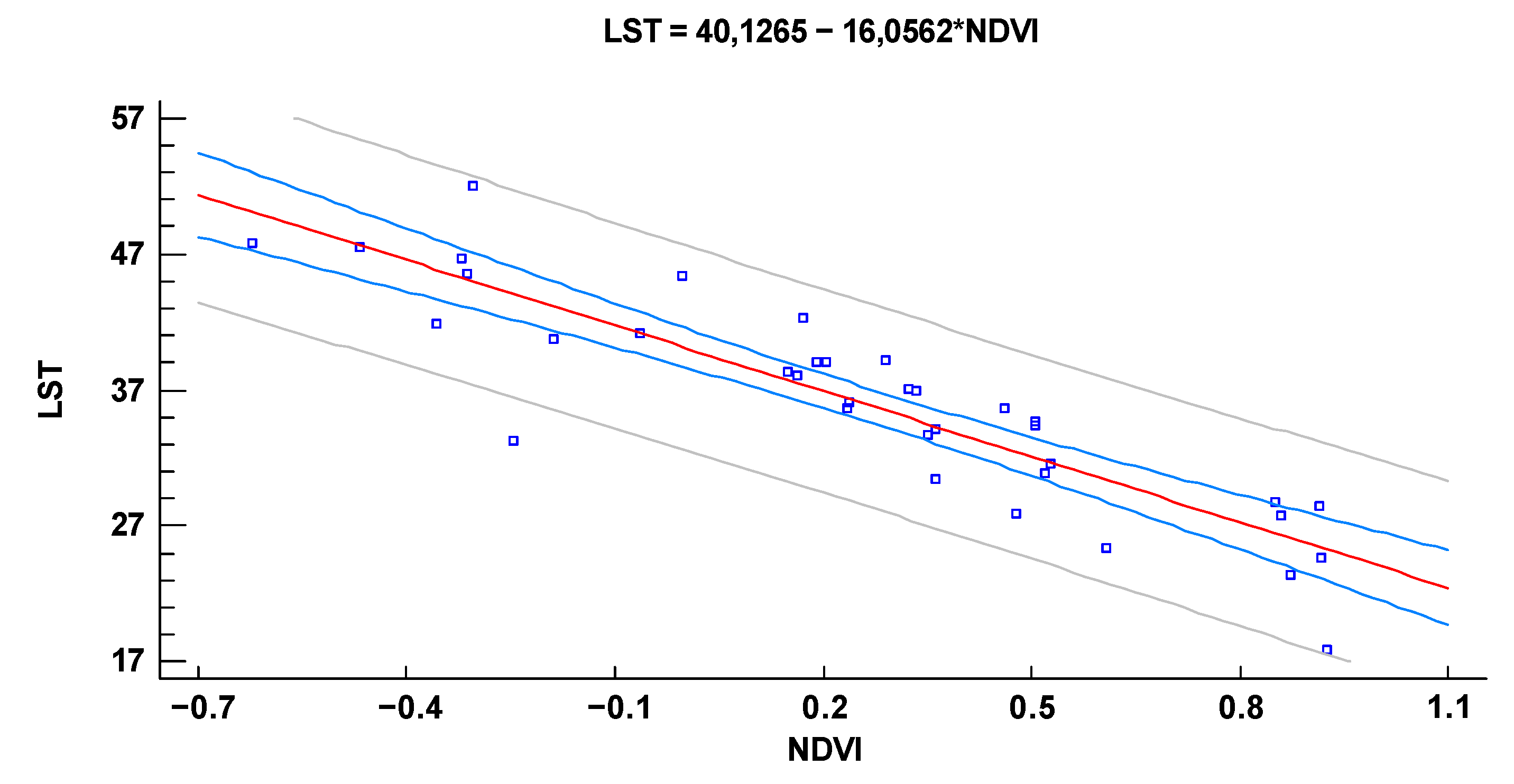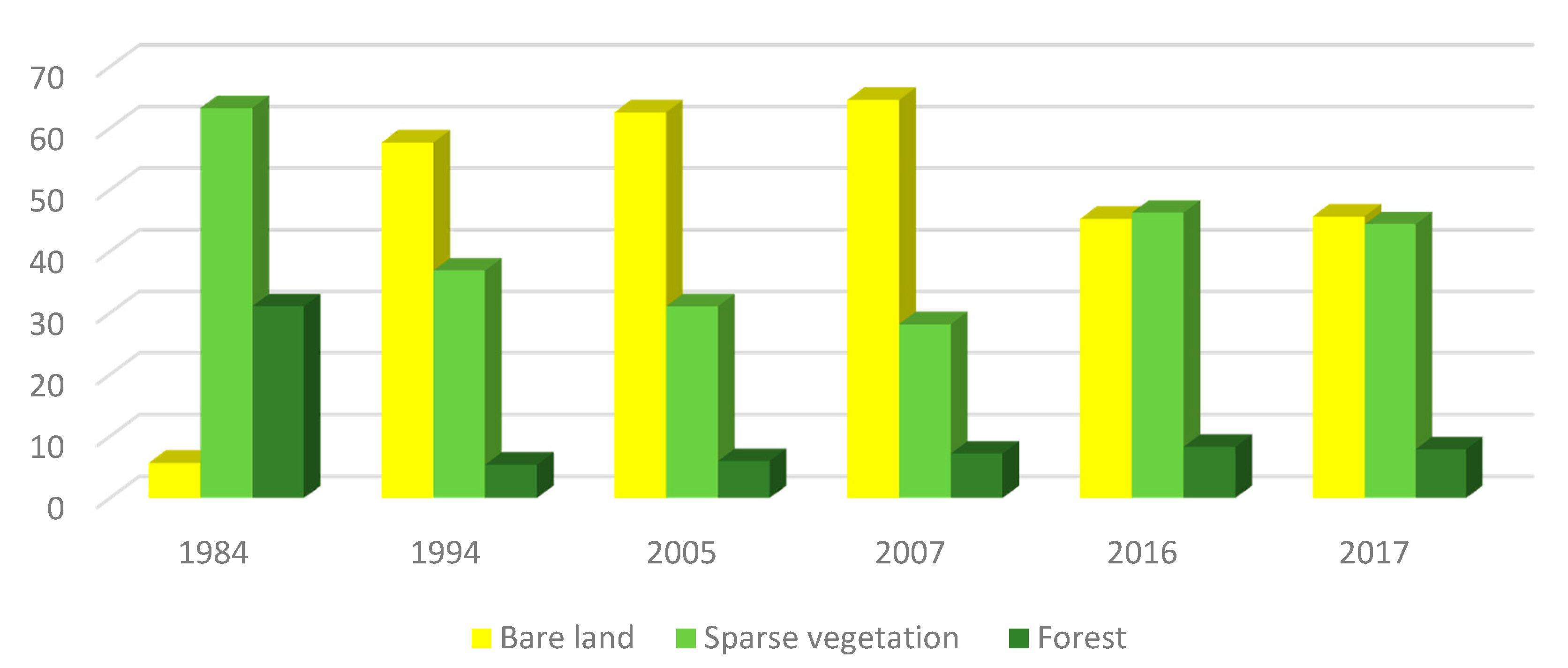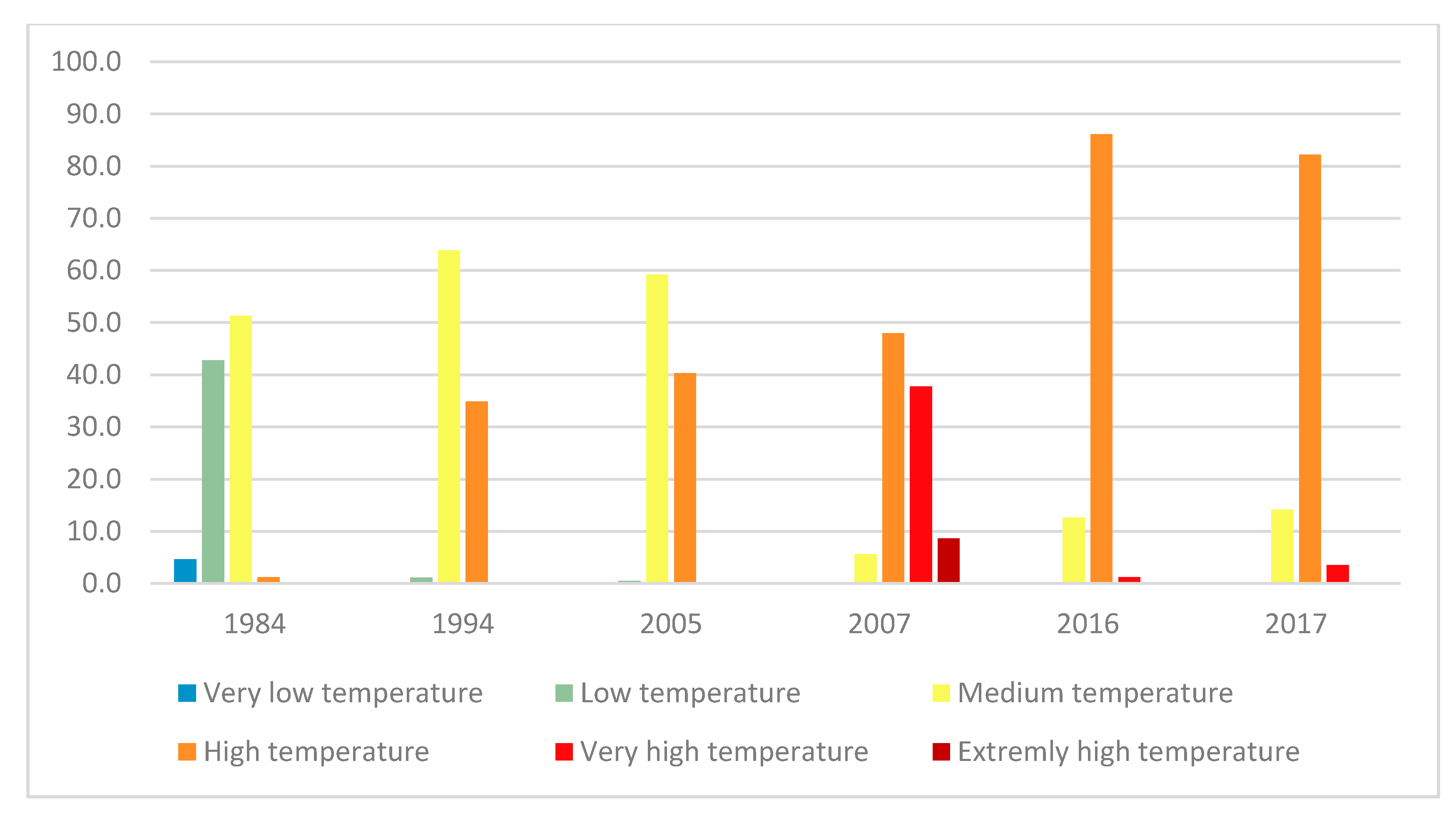1. Introduction
Morocco’s climate varies considerably from north to south. Rainfall and temperature are strongly influenced by the Atlantic Ocean in the west, the Mediterranean Sea in the north, the Sahara Desert in the south and southeast, and in particular by the position of the Atlas and the Rif mountains. This geographical and topographical characteristic of Morocco determines the distribution of rainfall over the country.
The increasing temperature in Morocco is associated with global climate change. The year 2017 was the hottest year on record, surpassing the previous high mark set in 2016. Similar trends have been recorded for Morocco and the Middle East and North Africa region, though there are year-to-year country-level variations from the global mean [
1]. With approximately global temperatures of 1.2 °C above pre-industrial levels.
Due to severe climatic conditions, deforestation, overgrazing, and poor planting techniques, more than 40% of the total area of Morocco have been affected by soil erosion. Climate has a direct effect on soil erosion through rainfall, runoff, and indirectly through vegetation. As a result, there is a strong link between vegetation, soil, and the phenomenon of degradation. Plant cover is an important factor in protecting soil from erosion by maintaining soil fertility and moisture. It can also play an important role in thermal protection: maximum temperatures under canopy cover are generally 2 to 4 °C lower than on surrounding agricultural land, and minimum are 1 to 2 °C higher [
2]. The role of thermoregulation played by vegetation covering river embankments was reported as follows: soil temperatures were almost 4 °C higher for vegetated embankments than for bare embankments. The destruction of vegetation leads in the long term to soil degradation and aggravated cases to desertification.
Rouse and his collaborators [
3] developed the NDVI (Normalized Difference Vegetation Index) using the red and near-infrared bands of the electromagnetic spectrum. The Vegetation Index reveals that the vegetation covers relative to the ground. It is mainly correlated with leaf chlorophyll activity. Indeed, chlorophyll pigments absorb strongly in the red and leaves reflect in the near-infrared. NDVI was used for the diagnosis and evaluation of the active vegetation. The spectral signature of plants ranges from a very active photosynthetic green state in wet weather to a very weak active dry state in dry weather, which has no distinct spectral signature to differentiate it from bare soil. High values indicate abundant and dense vegetation. These values progressively decrease as chlorophyll activity and vegetation decline. Several studies [
4,
5,
6] have been devoted to linking this index to a land cover structure parameter (percent land cover, green biomass, or leaf area index). LST is the main topic for developing methodologies to be measured from space. LST is an important factor in many study areas, such as global climate change, hydrological and agricultural processes, and urban land use/land cover [
7].
The higher NDVI index indicates the presence of vegetation, i.e., the quantity or state of vegetation. Land surface temperature (LST) is one of the key factors in the physical process of the Earth’s surface, combining surface-atmosphere interactions and energy flows between the atmosphere and the ground [
8,
9]. The lowest LSTs are generally found in areas with high NDVI. This negative correlation between NDVI and LSTs is valuable for urban climate studies found that the vegetation fraction is slightly more negatively correlated with LSTs.
Many researchers have tried to understand the increase in temperature in the world. Few studies have involved the continuous rise of temperature [
10,
11], while few others analyzed the relationship between LST-NDVI over Morocco, Europe, and North America [
4,
6,
12].
In Morocco, the arid zones represent 77% of the national territory and the Saharan regions alone occupy 60%. However, if we consider the arid zone in the broad sense, including the semi-arid regions where the risks of desertification are high, we end up with 90% of the territory [
13]. The region of Taza had become arid between 1961 and 2008 (according to the aridity index of de martonne) [
14].
The present work was conducted to investigate the evolution of the vegetation state in the Oued Lahdar watershed between 1984 and 2017, and its effect on land surface temperature increase (LST). During these years the soil recorded the effects of major drought episodes experienced in various regions of Morocco since the 1980s.
A literature review on drought in Morocco indicates that occurrences of drought during the 20th century grew steadily [
13,
15,
16]. The periods of drought were marked by the rise in soil temperature. The study by remote sensing of this index during 33 years allows us to contribute to diagnosing the degradation of the vegetation during the last decades. This method was used for the first time in Morocco and could contribute to combatting desertification, of which Morocco has a particularly rich history, which began in 1951.
1.1. Study Area
The Riffian domain is bordered by the Mediterranean Sea on more than 400 km of coastline and in its northwestern part, by the Atlantic Ocean, constitutes the most septentrional part of Morocco. Geologically, it is the only Moroccan massif resulting from the alpine orogeny, most of its facies having more affinities with those of Andalusia than with those of the rest of Morocco. Geographically, the reliefs are strong and uneven, with varied geological nature of the terrain (schists, marl, sandstone, limestone, etc.) [
14,
15]. This leads in particular to great variability in the potentiality of groundwater resources, and a dissymmetry of the hydrography between the Mediterranean slope (short wadis with very steep slopes) and the Atlantic slope (long wadis, with many tributaries).
The Oued Lahdar watershed is part of the Oued Inaouene watershed, which is itself a sub-basin of the Sebou (
Figure 1), covering an area of 3680 km
2. The Oued Inaouene is considered the second main tributary of the Sebou after the Oued Ouergha; it flows in an east-west direction along the southern Rif corridor, towards the Idriss I dam. It thus covers part of the External Rif in its left part, and part of the Middle Atlas in its right part, and its valley the southern Rif corridor Fez-Taza. This geographical position of the watershed of Oued Inaouene presents a very marked dissymmetry due to the contrast of the lithology of its two slopes: the southern limestone and dolomitic slope (Middle Atlas) presents harder facies than the northern slope (Rif) consisting of marly hills.
Oued Lahdar originates in the mountains of the Outer Rif, in the northern part of Oued Inaouene. The watershed of Oued Lahdar extends over the Outer Rif, which is characterized by a fragile terrain and high altitudes. The climate that dominates in the watershed is the Mediterranean with a continental oceanic influence. The average annual rainfall of the watershed varies between 600 mm and 800 mm/year.
In terms of vegetation, the Rifain region, due to its differences in altitude, facies, and humidity, offers a great diversity in the natural population and the crop range. The shrubby vegetation is represented in the western half of the Rif by the dwarf palm, or doum (Chamaerops humilis) and the mastic tree (Pistacia lentiscus), which combined with other species form an impenetrable scrubland. The eastern half is characterized by the jujube tree (Zizyphus lotus) esparto (Stipa ten acissima). These areas correspond roughly to those of the olive tree (replaced in altitude by the walnut tree) in the West and the almond tree in the East. The forest formations, which are generally very discontinuous, are mainly characterized by the following species: cork oak (Quercus suber) on the acid soils of the peninsula, holm oak (Q. ilex), and Q. pyrenaïca in the central mountainous areas with maritime pine (Pinus pinaster). Finally, the degraded soils that receive low rainfall are the domain of thuja (Callitris articulara), and Aleppo pine (Pinus halepensis).
As far as crops are concerned, the mountains have small, and often irrigated fields with supplementary livestock farming (usually goats), while the hills, particularly in the Prerif, have cereal crops. The irrigable plains bear market gardening crops.
1.2. Satellite Data
This study was carried out using satellite images coupled with detailed field observations, verification, and statistical analysis to assess the relationship between these variables. The satellite images were collected from the USGS data portal [
16]. A Landsat TM 5 (Thematic Mapper) satellite image dated 1984, 1994, 2005, and 2007, and Landsat OLI 8 (Operational Land Imager) dated 2016 and 2017. Satellite image pre-processing: Following the reading of the raw images, a generalized and systematic pre-processing phase was required. The pre-processing applied to the images included the following procedures: radiometric calibration and radiometric correction Fast Line-of-sight Atmospheric Analysis of Hypercubes (FLAASH). As we chose to map only natural vegetation and to exclude cultivated plants, the period chosen for the NDVI calculation was June/July. This choice was justified for LST by the fact that this period corresponds to the maximum temperature in Morocco.
Landsat series data are downloadable free of charge directly from the United States Geological Survey (USGS) website. The characteristics of the Landsat TM 5 and OLI 8 satellite sensors used in this study are presented in
Table 1.
1.3. Meteorological Data
Monthly and annual average precipitation and temperature data are calculated over the period 1984 to 2017. Rainfall patterns throughout the basin are very similar: heavy rainfall in winter, relatively minimum in autumn and spring, and very light rainfall in summer. The average annual rainfall increases from 383 mm at Meknassa, to 575 mm at Taza, 577 mm at Bab Merzouka. The increase in rainfall downstream can be explained by the influence of the Middle Atlas (
Figure 2).
4. Vegetation and Temperature Interannual Variability
Statistical analysis indicates a strong relationship between Land Surface Temperature (LST) and vegetation index (NDVI). This can help us conclude that, over time, the temperature increases when and where the vegetation cover decreases, and vice versa.
The study area is characterized by the presence of cultivated and wild plant species. However, since 1984, the vegetation cover of the study area has decreased significantly due to habitat fragmentation, overgrazing, deforestation, desertification, and other anthropic and climatic threats. This has a significant effect on the reduction of the area covered, and on the increase in temperature. The NDVI study reveals this alarming degradation of the vegetation
Between 1984–1994 (
Figure 8), natural vegetation covered 94.3% of the study area before being decreased to 43.3% in 1994, and the forest covering 31% of the watershed was reduced to 5%. The sparse vegetation such as grasslands or senescent shrubs and shrubs covered 63.2% was reduced to 36.9%. The bare ground, which affected 5.7% at earlier times, reached 47.7% in 2017.
Between 1994 and 2007, the vegetation cover continued to deteriorate progressively. Bare soil area increased to 64.6%, sparse vegetation continued to decline by 28.2%, even though the forest improved slightly by 7.2%.
From 2006 to 2009 within the framework of the LIFE-Pays-Tiers program (mainly Mediterranean and Baltic Sea countries), funded by the European Union. At the Moroccan level, the CRTS (Royal Center for Spatial Remote Sensing), the MAPM (Ministry of Agriculture), and the HCEFLCD (High Commission for Water, Forests and the Fight against Desertification) [
30], were involved in the nature conservation project, regeneration and forest management. It is thus fitting that the vegetation cover had improved noticeably between 2007 and 2017 in the study area.
In 2016, we can note that the bare soil area was reduced by 45.3% and the sparse vegetation layer significantly increased by 46.3%. Dense vegetation and forest also improved in the northwest area by 8.3%. Between 2016 and 2017, there was a slight deterioration, where the bare soil increased by 2.7%, the sparse vegetation layer decreased by 1.9%, while forests increased by 0.4% of the Oued Lahdar watershed.
The slight improvement observed can be explained by the exceptionally rainy years from 2008 to 2010 that had never been known since dry years similar to that of the 80s (INRA). In addition, Morocco adopted a National Action Program to Combat Desertification (NAP-CD) in June 2001 [
31]. As a result, several integrated projects have been implemented for the development of forest areas and arboriculture, in particular olive trees, the development of watersheds, rain-fed agricultural land, and rangelands, which in our study area can be explained by the increase in forests by 8% in 2016. Besides, stricter control of water, forest management, and agriculture on natural resources (water, forests, soils, etc.).
The geographical studies of the LST (
Figure 9) show that between 1984 and 1994, the temperature in the study area (the Oued Lahdar watershed) varied as follows: the low temperature covered 42% and decreased to 1.2% in 1994, the medium temperature covered 51% and became 63.9%, the high temperature covered only 1.2% before being increased to 34.6% later.
Between 1994 and 2007, the normal temperature area decreased continuously to 0.5% in 2005, while the medium and high-temperature areas were 59.2% and 40.3% of the total study area respectively.
The year 2007 witnessed an alarming increase in temperature in the entire study area, with the medium temperature covered 5.2%, the area with high-temperature presented 48%, where the one with very high covered 37.7%, and the extremely high temperature appeared with 8.7%. In 2007, the increase in LST reached maximum values, resulting from the combination of the last droughts recorded in the 1980s, 1990s, and the early 2000s and global warming of the planet.
From the years 2008–2010 which were exceptionally rainy, the LST started to drop, and also there was no significant drought after 2010. Areas with very high temperatures decreased (from 37.7% in 2007 to 1.2% in 2016 and 3.6% in 2017) in favor of areas with high temperatures, which increased from 48% to 86.1% and 82.2% in the same order. Areas with medium temperature increased from 5.6% to 12.6 % and 14.2% in the same order. The decreasing of LST still didn’t reach the normal state in the watershed Oued Lahdar.
5. Conclusions
This study explored the spatial and temporal relationship between LST and NDVI over the Oriental Rif of Morocco. LST and NDVI investigated over the last 33 years showed that the study area can be considered as a fragile state of the Mediterranean environment, which was impacted by multiple anthropogenic and climatic degradation factors.
From 1984 to 2017, the land surface temperature had increased from 1984 to 2007 due to droughts, while a gradual decrease was registered after 2007 due to the partial restoration of vegetation in the Watershed after the rainy years 2008–2010. This finding could reflect the effect of vegetation cover thermoregulation.
In Morocco, the rainy years after 2008 have reduced the negative effects of drought, and therefore, they have played a crucial role in the restoration of vegetation, which is showing good results in the Watershed of the Oued Lahdar.
In comparison with diachronic analysis, on aerial photographs between 1986 and 2006, authors assessed forest decline at the equivalent of 5000 ha/year [
15]. Another study reported the vegetation cover on Oued Sra watershed, neighboring Lahdar, showed that the forest cover which occupied 38% in 1986, decreased to 19% in 2006 and 15% in 2013 [
32]. Furthermore, in the Taounate region, forest cover decreased by 11.76% from 1982 to 1992 [
33].
The monitoring of land cover time series provides an overview of the increase or decrease of vegetation, while if we combine them with LST time series, they can become a good characterization of droughts in terms of identification and monitoring sensitive areas to be protected before reaching the desertification.
